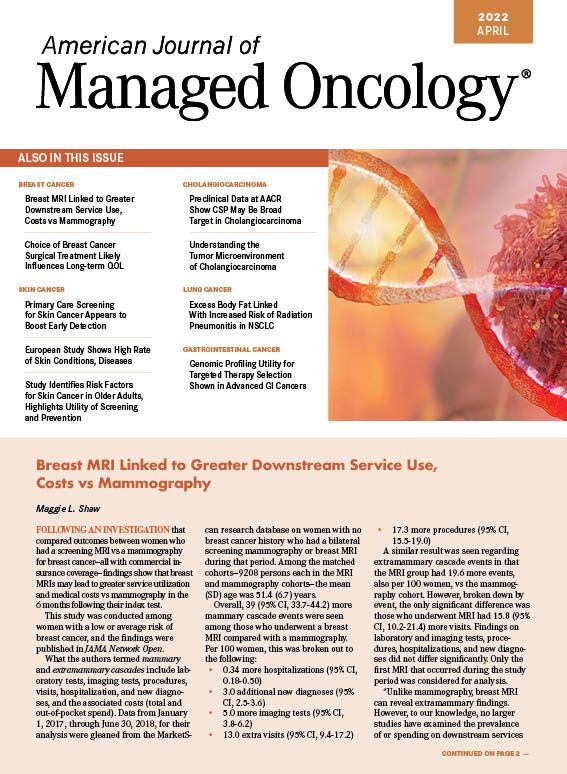- Center on Health Equity & Access
- Clinical
- Health Care Cost
- Health Care Delivery
- Insurance
- Policy
- Technology
- Value-Based Care
Breast MRI Linked to Greater Downstream Service Use, Costs vs Mammography
This investigation focused on use of additional services and incidence of new diagnoses among women who underwent a breast cancer screening MRI—having a low or average risk of the cancer—compared with a matched cohort who underwent mammography.
Following an investigation that compared outcomes between women who had a screening MRI vs a mammography for breast cancer—all with commercial insurance coverage—findings show that breast MRIs may lead to greater service utilization and medical costs vs mammography in the 6 months following their index test.
This study was conducted among women with a low or average risk of breast cancer, and the findings were published in JAMA Network Open.
What the authors termed mammary and extramammary cascades include laboratory tests, imaging tests, procedures, visits, hospitalization, and new diagnoses, and the associated costs (total and out-of-pocket spend). Data from January 1, 2017, through June 30, 2018, for their analysis were gleaned from the MarketScan research database on women with no breast cancer history who had a bilateral screening mammography or breast MRI during that period. Among the matched cohorts—9208 persons each in the MRI and mammography cohorts—the mean (SD) age was 51.4 (6.7) years.
Overall, 39 (95% CI, 33.7-44.2) more mammary cascade events were seen among those who underwent a breast MRI compared with a mammography. Per 100 women, this was broken out to the following:
- 0.34 more hospitalizations (95% CI, 0.18-0.50)
- 3.0 additional new diagnoses (95% CI, 2.5-3.6)
- 5.0 more imaging tests (95% CI, 3.8-6.2)
- 13.0 extra visits (95% CI, 9.4-17.2)
- 17.3 more procedures (95% CI, 15.5-19.0)
A similar result was seen regarding extramammary cascade events in that the MRI group had 19.6 more events, also per 100 women, vs the mammography cohort. However, broken down by event, the only significant difference was those who underwent MRI had 15.8 (95% CI, 10.2-21.4) more visits. Findings on laboratory and imaging tests, procedures, hospitalizations, and new diagnoses did not differ significantly. Only the first MRI that occurred during the study period was considered for analysis.
“Unlike mammography, breast MRI can reveal extramammary findings. However, to our knowledge, no larger studies have examined the prevalence of or spending on downstream services that may follow,” the authors wrote. “Further, extramammary cascades are rarely considered in breast MRI trials, cost-effectiveness analyses, guidelines, or shared decision-making discussions about breast cancer screening.”
When per-person costs were investigated, these were shown to be higher across the board for the participants in the MRI cohort compared with the participants in the mammography cohort:
- $1404 overall (95% CI, $1172-$1636)
- $564 for total spending (95% CI, $532-$596)
- $305 for mammary services (95% CI, $297-$313)
- $254 for extramammary services (95% CI, $244-$263)
- $42 for extramammary events (95% CI, $16-$69)
- $31 out of pocket (95% CI, $6-$55)
The authors noted that because the use of screening breast MRIs is on the rise, so are concerns about greater use of subsequent and potentially harmful health care services—including follow-up imaging—particularly because breast MRIs “are less specific than mammography for breast pathology,” they wrote.
Their findings hold significance because they echo previous research, particularly that on nonmammary cascade events and costs. In addition, even though their spending totals are “modest,” the authors noted, extrapolating those amounts to 52.6 million women (based on 2020 US census data) would equate to $53.4 million in extra costs related to mammary cascades and $4 million more related to extramammary cascades. They also highlight potential harms from overdiagnosis and overtreatment of breast cancer and point out that “repeated exposure to gadolinium contrast is another concern that is not well understood.”
“The additional testing and related insurer and out-of-pocket spending has important implications for understanding the benefits and harms of MRI screening at the population level and for assisting women in shared decision-making about MRI screening,” the authors concluded. “Our findings underscore the importance of avoiding screening breast MRI in low or average-risk women for whom potential harms from screening outweigh potential benefits.”
Reference
Ganguli I, Keating NL, Thakore N, Lii J, Raza S, Pace LE. Downstream mammary and extramammary cascade services and spending following screening breast magnetic resonance imaging vs mammography among commercially insured women. JAMA Netw Open. Published online April 13, 2022. doi:10.1001/jamanetworkopen.2022.7234

